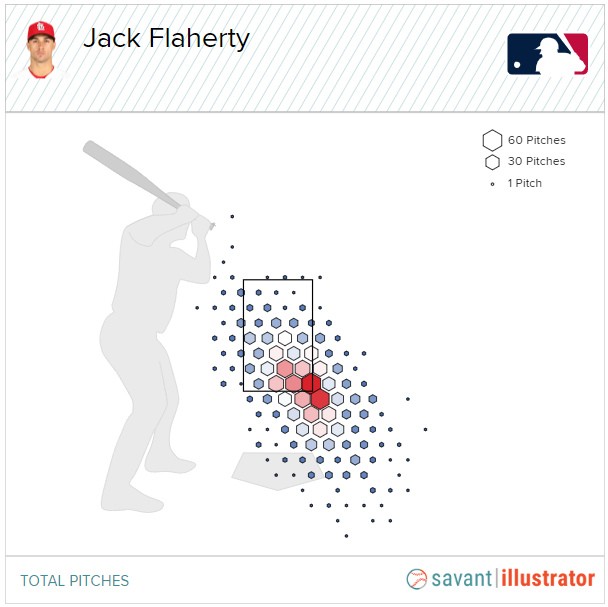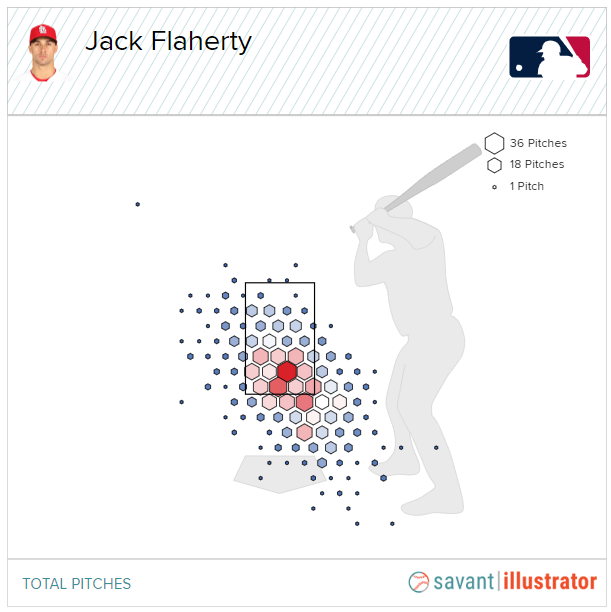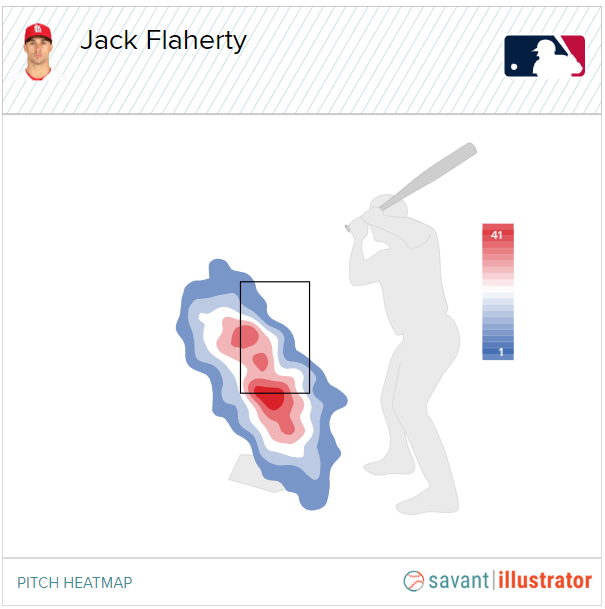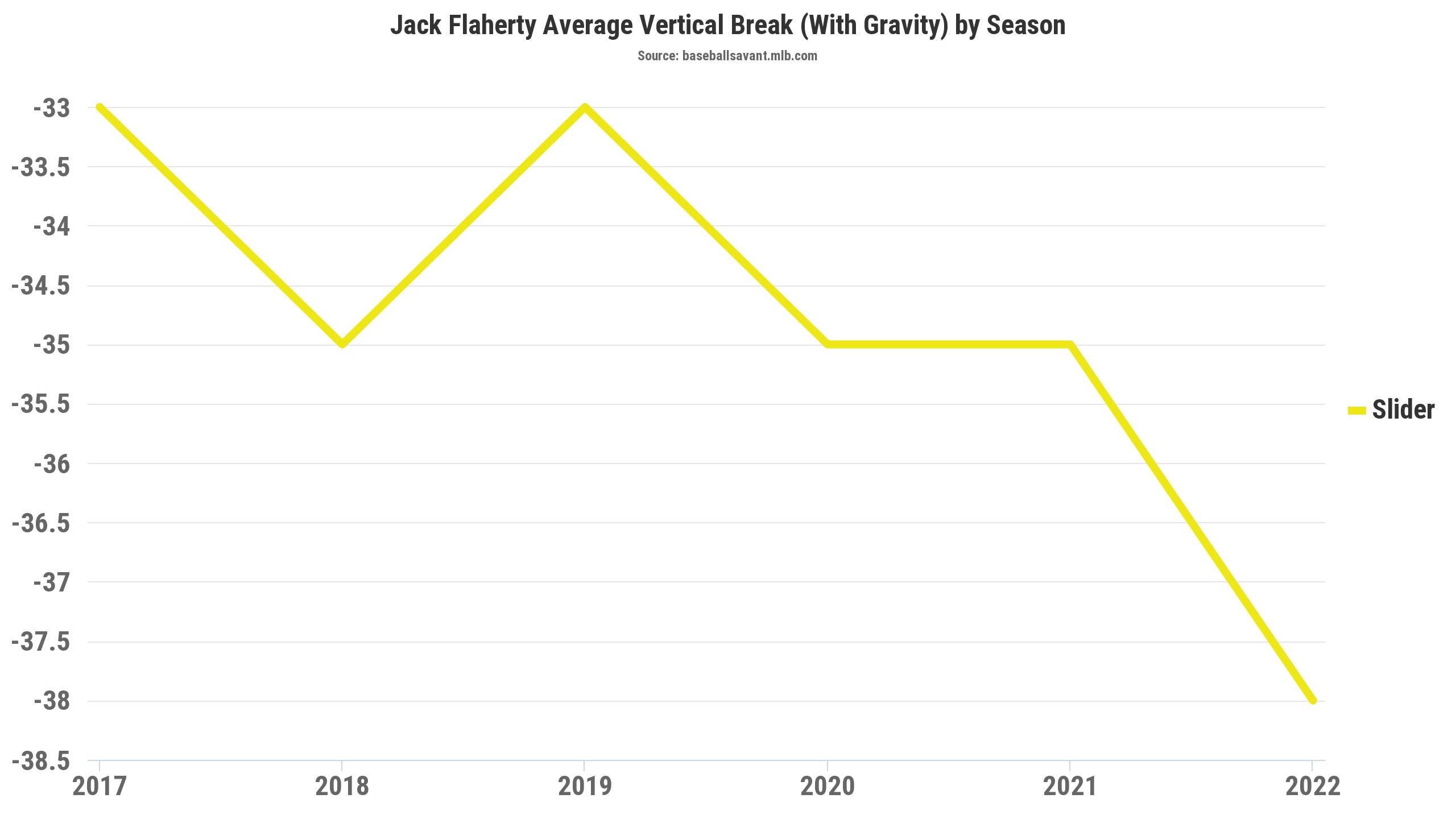It’s been a tumultuous few years for Jack Flaherty, who doesn’t go into 2023 with the expectations we probably thought he would have at this stage of his career.
He got his first real chance in the league in 2018 as the 38th-ranked prospect in all of baseball (these lists are always fun to revisit years later), where he put up a 3.34 ERA and 1.11 WHIP in 151 IP with 182 K. 2019 was his year though, as his second-half was one of the best in MLB history. He struggled thru the first half with a 4.64 ERA, then put up an absurd 0.91 ERA and 0.71 WHIP in the second half: good for fourth in NL Cy Young voting that year.
What happened from there? Well, a mix of some injuries and overall bad luck. 2020 was marred by the pandemic overall, but it caught the Cardinals particularly harshly throughout the season. 2021 was limited largely by an oblique injury followed by a shoulder strain that held him out another month later in the season. Finally, 2022 was derailed before it even took off: Flaherty had a “slight tear in his shoulder” which kept him from Major League competition until mid-June. Across these three seasons, Flaherty threw just 154.2 IP with a 3.90 ERA, 4.37 FIP, and 1.23 WHIP. However, faith wasn’t entirely lost during this time at all. The List had Flaherty as the #10 fantasy SP entering 2020, #14 in 2021, and #16 in 2022. His falling slightly down the ranks was more a matter of others doing more, whereas we hadn’t truly seen Flaherty in a rhythm during that time.
Now, both the October rendition of The List and projections are counting him out. Flaherty appears as the #53 fantasy SP, nowhere close to where he’s been listed before, and the currently available projection systems (Steamer, ATC, and The Bat) have a median projection of a 4.13 ERA and 4.31 FIP in 144 IP. It’s a big step back for someone who was once considered ace material, but there’s reason to believe that he can return to his old form.
Stopping and Starting
While injuries obviously halt any rhythm that a pitcher might have, Flaherty has seemingly gone down with injuries immediately after coming back from another. While I won’t go through the ins and outs of the chaotic Cardinals COVID outbreak in 2020, it was bad enough that Flaherty had to turn his hotel room into a makeshift bullpen. In 2021, he was cruising before a strained left oblique sidelined him. 7 of his first 11 starts were 6 innings or longer and he posted a 2.90 ERA with a 26.3% K-rate and 7.8% BB-rate. After coming back in August, Flaherty made just three starts before his shoulder strain: 6 IP, 6 IP, and 2 IP (where he got hurt). He returned a month later to make just three relief appearances, none being more than an inning.

Looking at his pitch velocities by start over the course of 2021, there is a clear difference between pre and post-injury. First, he was progressively throwing harder as the season went on. This is consistent with his 2018 and 2019, where his fastball velocity was peaking by September of both years. It’s unclear if that is related to the warmer months or simply just being more comfortable with more innings, but regardless, it is not the case in 2021. His velocity was down when he returned from injury in August, and then not surprisingly dropped off in the game where he injured his shoulder.
While it seemed like the offseason came at the right time for Flaherty, it’s unclear if he truly got healthy between 2021 and 2022. Early in Spring Training of 2022, Flaherty was diagnosed with a small tear in his shoulder, requiring a plasma injection and a few weeks of rest. He declined to comment on if he threw off a mound that off-season. Flaherty didn’t start his throwing program until mid-April and didn’t face live hitters until late May. His first rehab start was in the first week of June, where he sat 92-94mph.
Flaherty finally made his first start of 2022 on June 15th against the Pirates, where he gave up three runs in three innings. He made two more short starts, none with more than 71 pitches, before hitting the IL again due to shoulder soreness. In his brief time with the Cardinals in June, his fastball was still only around 92mph. The soreness caused the Cardinals to shut down Flaherty once again, a familiar phrase for Cardinal fans at the point; many were desperate for an ace for the contending club (who then went out to acquire an impact arm in Jordan Montgomery).
When he made his second rehab stint of the year in mid-August, things looked a little different. During his August 16th rehab start, Flaherty touched 98mph, something he’s only done twice in his career on an MLB mound (both in 2019).
Jack Flaherty ends the top of the 3rd with the 97 MPH fastball up in the zone for the K.
This was one helluva 9 pitch at-bat that saw Flaherty hit 98 MPH that Joe Rizzo fouled off five pitches during.
Flaherty's line: 3 IP, 2 H, 0 R, 1 BB, 4 K. 52 pitches, 34 strikes pic.twitter.com/aKnOPFi38S— Kyle Reis, 58% Neanderthal (@kyler416) August 17, 2022
Flaherty was strong in his rehab starts and was finally able to return to the Cardinals on September 5th and survived until the end of the season. In 28 IP over five starts, Flaherty looked like a shell of his former self. He posted a 3.86 ERA, but that came with a 4.40 FIP, 1.46 WHIP, and just an 11.2 K%-BB%.
However, going into 2023, we see a sentiment from the Cardinals that was not established in previous seasons. At the Cardinals Winter Warm-Up in mid-January, President of Baseball Operations John Mozeliak stated, “He’s had a really good offseason. His preparation has been very strategic and he’s in a good spot. I think he understands the importance of this year.” In the same article, Flaherty himself discusses that he’s reassessed where he is mentally and that he is in a better place. He often wears his emotions on his sleeve, both on the mound and in the media, which many Cardinal fans often use as cause for complaints.
2023 feels like a fresh start for the former ace, which is good for all parties involved.
The Ace Caliber Stuff
Obviously, these expectations wouldn’t surround Flaherty if he didn’t have lights-out stuff at times. His bread and butter are his two primary pitches: his four-seam fastball and slider, which make up about 70% of his pitches each year. He also has a curveball as a third offering and additionally has a sinker and changeup for when needed.
To start, his fastball sits at around 94mph (when healthy!) and thrives by working east and west in the zone as it doesn’t have that elite velocity. That is, living on both edges of the plate and not necessarily trying to overpower hitters with a high fastball. When Flaherty puts a little more oomph on the pitch, running it up to 98mph, he prefers to keep it down and away.
https://gfycat.com/glaringlawfulbadger
His strong location of the fastball makes it his both strike-getting pitch and contact-inducing pitch. Flaherty’s fastball has a called-strike rate of about 20%, a respectable figure as he commands it throughout the zone. The fastball also has about a 40% groundball rate across his big league career, a step above the 34% MLB average for the pitch. He also benefits from having the strong Cardinal defense behind him on those groundballs, which definitely does him more favors than not when the ball is put in play.
Flaherty makes the most of his fastball, as it is essentially an above-average pitch but thrives due to how good the slider is. From 2018-2020, Flaherty’s slider posted a strong 34.8% CSW%, which is largely built from the swings and misses the pitch gets.
| Year | CSW% | SwStr% | Whiff% | O-Swing% | Z-Con% |
|---|---|---|---|---|---|
| 2018 | 35.7% | 25.0% | 47.2% | 33.1% | 61.5% |
| 2019 | 33.5% | 20.1% | 39.3% | 37.5% | 71.0% |
| 2020 | 37.4% | 26.2% | 49.5% | 40.0% | 73.7% |
| 2021 | 32.6% | 20.6% | 40.5% | 33.2% | 75.0% |
The pitch doesn’t necessarily get an outrageous amount of chases out of the zone, it’s just great at avoiding bats when put in the right place. As Flaherty uses this pitch predominantly against right-handed hitters, he puts it in the perfect location.

This is the pitch location from 2018-2021 against RHB, which could not be placed in a better spot.

He still uses the pitch about 20% of the time against lefties, where it’s thrown more in the middle of the zone. Even though that looks to be a less-than-ideal location, it’s still an effective pitch, with a .172 AVG against. Across all of his sliders, they have .187 AVG against and .266 wOBA, making it a pitch that is difficult to do damage to. Furthermore, it had a minuscule 13% hard-contact rate, just about half of the league average of 23% HC% on sliders.
Next, his curveball is an offspeed he uses almost exclusively against LHB, as the slider is so effective against righties he doesn’t need to show it very often. Against lefties, the slider and curveball are almost interchangeable in terms of usage.

This chart shows the heatmap of curveball locations against lefties. Flaherty focuses the curveball as a backdoor pitch, attempting to grab the outside corner or have the shelf fall off and spike it into the dirt.
https://gfycat.com/unimportanthandygosling
The curveball has a .208 AVG against LHB and an absurd 42% K-rate.
His sinker, which is only used about 5% of the time, is thrown when Flaherty is ahead in the count, where it is either out of the zone entirely or gets a groundball. It’s thrown at around 90-91mph, which will most likely catch a hitter by surprise rather than overwhelm them.
Finally, the changeup is used exclusively early in counts. Similar to the sinker, it is used when hitters might be sitting on the fastball and is not really trustworthy to be used as an out pitch.
What to Make of 2022 Innings
While there is not much that can be taken away from just 36 IP in 2022, there are two noticeable differences in his pitch mix. He introduced a cutter in 2022 and changed the shape of his slider. The cutter is a new toy he had for dealing with lefties, but it still is a work in progress. It has 3.1 inches more horizontal break compared to the average cutter at a similar velocity (+-2mph to 88mph), which gives it a shape that looks more like a hard slider than a cutter.
https://gfycat.com/pointeddazzlingantelope
While this is an interesting development and could become very useful for Flaherty, it is something that needs more development time. It had just a 23.5% zone rate and 17.6% CSW, both very poor figures. He needs to be able to throw this more in the zone for it to become viable.
As for the slider, it dramatically changed in terms of its vertical movement between 2018-2021 and 2022. For the majority of Flaherty’s career, his slider hovered around 2.5 inches of vertical movement below the league average for sliders at a similar velocity. In 2022, the pitch was 0.5 inches of vertical movement above the league average (meaning that there’s more vertical break to it).

All of a sudden, in 2022, the pitch had 38 inches of vertical break. That didn’t necessarily make it a better pitch, unfortunately. The slider had a 16.9% SwStr%, down from the 20% mark in 2021 and even higher in 2018-2020. While there might not have been a true sample size to understand the effects this movement change had, it was not off to a good start. For reference, here’s a 2019 version of the slider:
https://gfycat.com/evilimmaterialballoonfish
And the 2022 version:
https://gfycat.com/gargantuancooperativeamericanwigeon
It does take a minute to adjust to the difference in camera angle (thanks Busch Stadium, ugh), but the newer version of the slider does show that steeper drop to it. I don’t think this is something that we can take at face value from 2022 stats, as 36 IP isn’t anything to draw conclusions from. It’s just yet another wrinkle into how to evaluate Flaherty going into 2023. He could be trying to do something Zac Gallen-esque, where he has a cutter and slider that can work off of each other. Even though the injuries make it hard to evaluate the actual talent of Flaherty, these changes prove that he is still developing as a pitcher and has more in the tank.
2023 Usage
Notably, this year is a contract year for Flaherty, meaning that he is going to want to be healthy and show that he still can be the 2018/2019 version of himself. Assuming what both Mozeliak and Flaherty said this winter is true, the Cardinals are going to let Flaherty go without precaution come the 2023 regular season. He will be able to ramp up in Spring Training normally, freeing himself of any pitch counts for the regular season, and we might even get a BSOHL notice (best shape of his life, like 100 other players). But in Flaherty’s case, there has been so much up and down over the last two years that going into 2023 might be better than anything in the last 1.5 seasons.
The median projection for his innings total is 144 IP, suggesting that he may miss a few starts but otherwise he should be consistently on the mound every fifth day.
If Flaherty can show the velocity is still there, which he showed in 2022, and become comfortable with his breaking pitches again, there’s nothing stopping him from flashing the ace material that he once had.
Photo by Ric Tapia/Icon Sportswire | Adapted by Doug Carlin (@Bdougals on Twitter)

